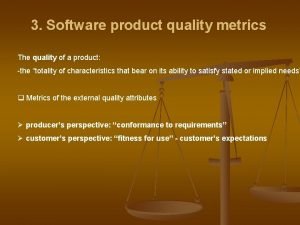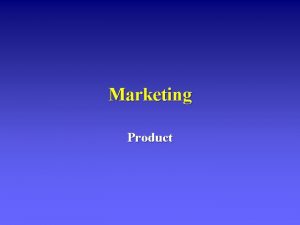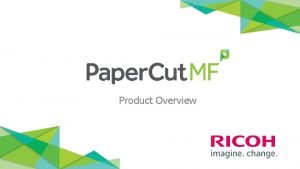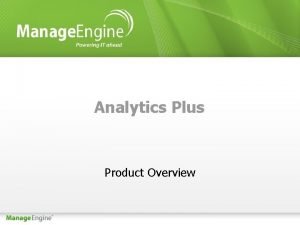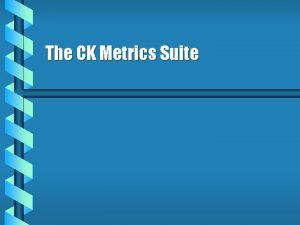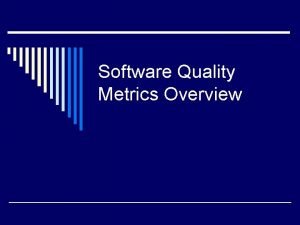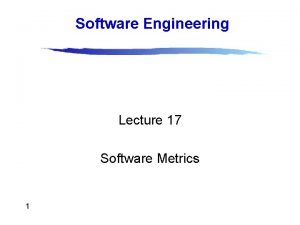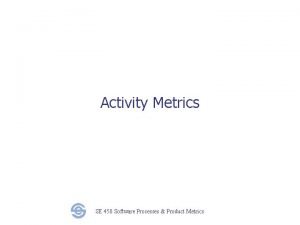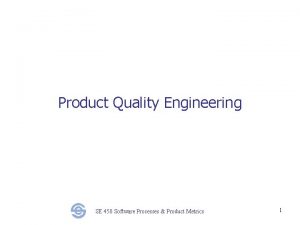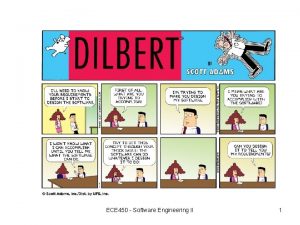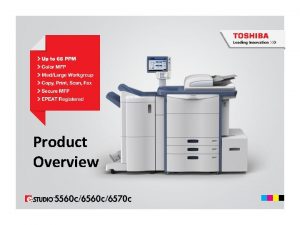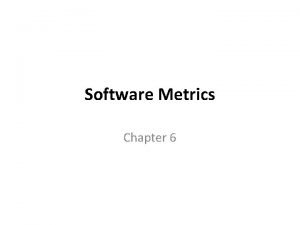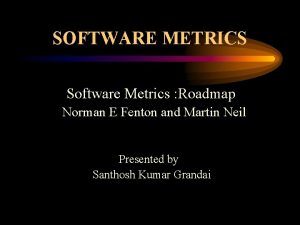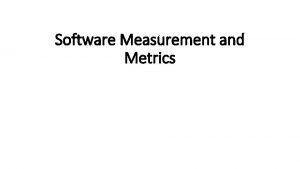Software Metrics Overview SE 450 Software Processes Product












- Slides: 12

Software Metrics Overview SE 450 Software Processes & Product Metrics

Measurements & Metrics n n n Measurements: Raw numbers. Metrics: Derived numbers that: n Indicate the extent to which some objective is being achieved. n Facilitate cross-comparison. n Can serve as the basis for actions to improve achievement of the objective. Identifying useful metrics is hard work! n Many times, we can’t find any for some objectives. SE 450 Software Processes & Product Metrics

Measurements for Software n Size: Lines of code, function points. n Time and effort for different project activities. n n n Defects found, classified by phase occurred, phase found, module, type, severity. Failures and when they occurred. Staffing, requirements changes, customer satisfaction (survey results), etc. SE 450 Software Processes & Product Metrics

Metrics for Software n n n Product Metrics n Indicate the quality of the product produced. In-Process Metrics n “Barometers” to indicate whether the process appears to be “working normally”. n Useful during the development and maintenance process to identify problems and areas for improvement. Project Metrics n Indicate whether project execution (business aspects) are on track. SE 450 Software Processes & Product Metrics

Software Metrics – Things to Consider As you see each metric, think about: • How useful is it? How would this be used? • How meaningful is it? • How easy is it to gather? How much extra work is it for developers to generate the numbers? • Are there ways to “beat / defeat” this metric? – Can you “make it look good” in ways that don’t achieve the objectives? • What other metrics do you need to get a balanced picture? SE 450 Software Processes & Product Metrics

Product Metrics Overview n Performance n Lots of measurements, lack of good metrics. n n n AFAIK (“As Far As I Know”) disclaimer applies to lots of these. Reliability n Defect density: Defects per KLOC (“ 1000 lines of code”). n Failure intensity: Number of failures per (hour of) operation. Availability n Uptime % Usability n SUMI score: user survey results, relative to “state-of-the-art”. Evolvability, safety, security. n Metrics are more like measurements, value as indicators debatable. Overall n Customer satisfaction: results of customer surveys n Customer reported defects: defect reports per customer-month SE 450 Software Processes & Product Metrics

In-Process Metrics: Quality n n n Reliability growth pattern. n Failures during system testing plotted vs. time. n Expected: spikes during each release, decrease over time. n Magnitude of spike related to significance, volume of changes. Pattern of defects found (arrivals) during testing. n Test defects found plotted vs. time during testing. n Should decrease significantly close to release. n Can project “latent defects” (defects left at release) from this. Defect density (can be tracked during development as well). n Defects per KLOC (can be classified by type, module). n n Highlights “hot spots”. Post-release defect density (product metric). n Strong indicator of effectiveness of testing (if product is used!) SE 450 Software Processes & Product Metrics

In-Process Metrics: Maintenance n n n Backlog Management Index n Rate of problem arrivals / rate of closure. n Should be close to 1, at least for high severity. Responsiveness of fixing. n Mean closure time, age of open & closed problems, % late fixes n Should stay within target values Fix quality n Number and % of defective fixes (didn’t work or created new bugs). SE 450 Software Processes & Product Metrics

In-Process Metrics: Management n n n Cost of Quality n Total effort on quality assurance activities: testing, reviews, procedures. n Should be as low as possible – high may indicate “perfectionism”. Cost of poor quality n Total effort expended on rework. n Should be within range (what if it is “too low”, isn’t that great? ). Phase containment effectiveness / defect removal effectiveness. n What % of the errors were detected within that phase? n Shows effectiveness of reviews and other quality procedures. n Preferably around 0. 7 or so. n If it is 0. 97, is that good? (It is an opportunity. ) SE 450 Software Processes & Product Metrics

Project Metrics n n n Cycletime n Elapsed time from requirements to delivery. Productivity n Size of delivered software / total effort. Rate of Requirements Change n % of requirements that changed plotted vs. time. n High requirements change will affect estimation accuracy, cycletime, quality. SE 450 Software Processes & Product Metrics

Project Metrics - Continued n n Estimation Accuracy n % difference between estimated and actual. n Can be done for cycletime, effort. Staffing Change Pattern n % of turnover (entered, left) plotted vs. time. n High staffing change will impact productivity, quality. SE 450 Software Processes & Product Metrics

Conclusion n n There do exist a number of metrics that can give a meaningful picture of what is going on in a project. By designing a metrics program that uses multiple metrics in conjunction with each other, we can get a balanced picture. Most of the metrics come from relatively little raw data: size, effort, defects / failures, timeline data. There are metrics that can help to identify problems and areas of improvement, as well as metrics that evaluate results. SE 450 Software Processes & Product Metrics
 Trigonometri
Trigonometri Software product quality metrics
Software product quality metrics What is software metrics in software engineering
What is software metrics in software engineering What is software measurement
What is software measurement Concurrent processes are processes that
Concurrent processes are processes that Product line depth
Product line depth Papercut job tickerting print management
Papercut job tickerting print management Introduction product overview
Introduction product overview Introduction product overview
Introduction product overview Introduction product overview
Introduction product overview Ck metrics in software engineering
Ck metrics in software engineering Types of software metrics
Types of software metrics Data structure metrics
Data structure metrics

